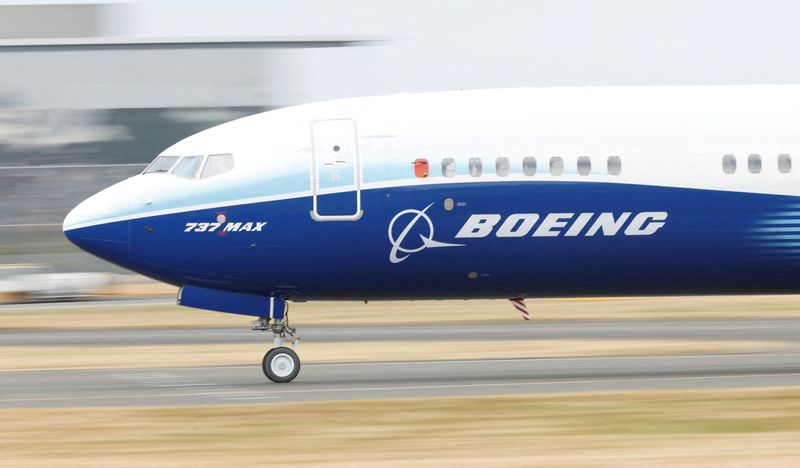By Rajesh Kumar Singh, David Shepardson and Abhijith Ganapavaram
CHICAGO (Reuters) - Boeing (NYSE:BA) Co's top executives on Wednesday forecast a ramp-up in jet deliveries and higher free cash flow next year, as they sought to reassure skeptical investors the planemaker was recovering from a crippling slowdown following the pandemic and the grounding of its best-selling jet after fatal crashes.
The U.S. aerospace giant told investors and analysts at its first public investor meeting since 2016 that it expects to deliver 400-450 MAX planes next year, more than the 375 single-aisle planes it expects to deliver this year. It expects to deliver 70-80 787 planes in 2023.
It estimates to deliver 800 commercial jets at least by 2025 as it expects to produce 50 MAX planes and 10 787 jets per month. The production rate for MAX planes currently stands at 31 a month, while it is aiming to gradually increase the production rate for 787 to five per month.
Boeing shares were up about 6.5% at $152.84 in afternoon trade. They have fallen 29% this year, steeper than the 19% decline in the S&P 500 index, as Boeing has fallen short of Wall Street earnings estimates for five straight quarters.
Investors have been skeptical of Boeing's targets due to production delays, cuts in the jet delivery outlook and mounting losses at its defense business.
The company last month predicted it would deliver 375 MAX planes this year, lower than a July target of "low 400s." At the start of the year, it had planned to deliver about 500 of the single-aisle aircraft.
At the investor conference, some analysts questioned the company's production and delivery targets, citing supply-chain bottlenecks. Chief Executive David Calhoun, however, said the company has taken into account all the potential challenges.
"We believe the plan that we have out here, the guidance that we've provided is doable," said Chief Executive David Calhoun. "If we didn't, we wouldn't put it up."
He said the latest forecasts are not contingent upon resumption of jet sales to China.
Both 737 MAX and 787 jets hold the key to the company's free cash flow and profits. Boeing needs to shore up its cash flow to help pay off the debt it accumulated to get through the overlapping crises.
Colin Scarola, an analyst at CFRA, said while Boeing has developed a "bad" reputation for missing its targets, the outlook shared on Wednesday is "pretty conservative" and is "achievable."
"Operationally, I am feeling much better about Boeing than I did last week," Scarola said.
Boeing's production and regulatory delays have made it harder for its customers to ramp up capacity to capitalize on booming travel demand.
The company faces a late December deadline for the Federal Aviation Administration (FAA) to certify MAX 7 and MAX 10 planes under existing rules.
Boeing said it expects to secure certification of MAX 7 later this year or early 2023 and of MAX 10 planes by late 2023 or early 2024.
It expects to generate $3 billion-$5 billion in free cash flow next year, higher than $1.5 billion-$2 billion expected this year. As jet deliveries ramp up, its annual cash flow is estimated to jump to about $10 billion by 2025 or 2026.

"The playbook for us is very straightforward - deliver airplanes, generate cash, pay down debt," Chief Financial Officer Brian West said.
(This story has been refiled to fix typographical error in the quote in paragraph 12)